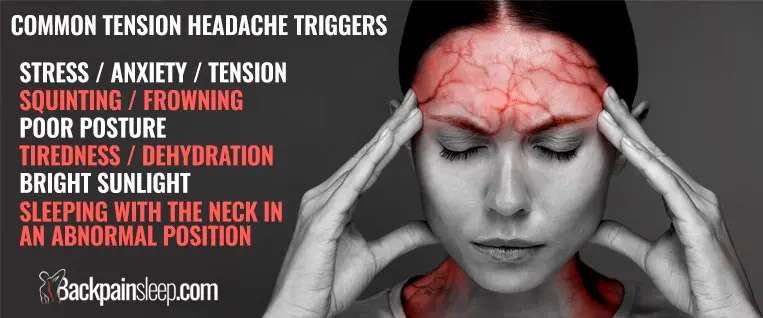With this information, you and your doctor will be able to determine the best therapy for your headaches and even try to prevent them.

Headache Types
There are more than 150 forms of headaches, but the most frequent are:
Tension Headaches
Adults and teenagers suffer from tension headaches the most. Over time, they produce mild to severe discomfort. In most cases, there are no further symptoms.
Migraine Headache
A throbbing, hammering pain is a common description of migraine headaches. They can last anywhere from four hours to three days and occur once or twice a month on average. Other symptoms include sensitivity to light, noise, scents, nausea, vomiting, a lack of appetite, and an upset stomach or discomfort in the abdomen. Symptoms of migraine in children include paleness, dizziness, blurred vision, a fever, and nausea. A tiny percentage of children with migraines experience stomach problems, including vomiting, about once a month.
Cluster Headaches
The area behind or around one eye may be excruciating, burning, or piercing. It might be a throbbing pain or one that is there all the time. Cluster headache sufferers generally can’t sit still due to the excruciating pain and may frequently pace when experiencing an episode. The eyelids droop, the eye reddens, the pupil shrinks, or tears form on the side of the eye, experiencing discomfort. There’s a problem with the nose on that side.
Cluster headaches get their name because they tend to occur in clusters. They are capable of arousing you from a sound slumber. During a cluster phase, which can run from two weeks to three months, you may have them one to three times a day. For 15 minutes to three hours, a headache episode lasts. Sometimes, the headaches go away for months or years (your doctor will term this a remission), only to return later. They are three to four times more common in men than in women.
Daily Headaches
For more than three months, you’ve been experiencing this sort of headache on at least 15 days out of the month. Some of them are a little on the short side. Others are longer than four hours long. The following are the four most common kinds of primary headaches:
- Migraine headaches are a daily occurrence
- Tightness in the head and neck
- Persistent everyday headaches are now a daily occurrence.
- Continued hemicrania is the norm.
- Headaches Due to Congestion
You’ll have continuous, deep pain in your cheekbones, forehead, or on the bridge of your nose if you suffer from sinus headaches. Because a sinus infection is the cause of a sinus headache, the mucus that drains from your nose is yellow or green rather than the clear mucus found in migraines or cluster headaches. Inflamed sinuses can lead to a runny nose, sneezing, and a runny nose. Other sinus-related symptoms, such as a runny nose, stuffy ears, a fever, and a bloated face, are frequently associated with the discomfort.
Symptoms of Traumatic Stress Disorder
After a head injury, post-traumatic stress headaches are most common within the first two days. You’ll experience:
- Unpleasant discomfort that grows worse now and then
- Vertigo
- Lightheadedness
- Having difficulty focusing
- There are memory issues.
- Getting worn out soon
- Irritability
For other people, headaches might continue for months. However, if the symptoms persist for more than a few weeks, you should consult a physician.
Headaches During Exercise
The muscles in your scalp, neck, and head require higher blood flow while you’re active. As a result, your blood vessels enlarge to provide enough supplies. For 5 minutes to 48 hours, you may have throbbing pains on both sides of your head. Whether you’re exercising or having sex, you’re more likely to get it while you’re in the middle of it.
Hemicrania Continua
Almost invariably, on the same side of the face and head, hemicrania continua is a persistent, ongoing headache. Other signs and symptoms to watch out for are:
- Pain that can range from mild to severe
- Tearful or red eyes
- Inflammation of the nasal passages
- A drooping eyelid
- Ocular constrictions
- Indomethacin is a painkiller that works for him.
- Pain that worsens while you exercise
- Drinking alcohol causes more pain.
Migraine sufferers may also experience the following signs and symptoms:
Vomiting and diarrhea
Light and sound sensitivity
Types: There are two
Chronic: You suffer from headaches regularly.
For the next six months, you’ll be plagued with headaches. After a few weeks or months away, they return.
Headaches Caused by Hormones
During your menstrual cycle, pregnancy, and menopause, hormonal changes can cause headaches. Also, headaches can be brought on by the hormonal shifts brought on by birth control tablets and other hormone replacement therapies. Menstrual migraines occur two days before or within the first three days of your menstruation.
Headaches that Have Recently Begun to Recur regularly (NDPH)
These can appear out of nowhere and last for three months or more. Many people can recall precisely when their suffering began.
There is no known cause for a headache like this one. It can occur due to an infection, a flu-like sickness, surgery, or a stressful life event for certain individuals.
Generally, the discomfort is mild, but it can be excruciating for some people. It’s also difficult to cure.
Symptoms might be very different from one person to the next. Some people describe them as having the feeling of having a tension headache. Nausea and sensitivity to light are other migraine symptoms.
If your headache doesn’t go away or if it’s really severe, you should see a doctor immediately.
Overuse Headaches
The term “medication overuse headaches” may also be used to describe them. It’s dangerous to use painkillers more than three times per week or ten days per month, regardless of whether they are prescribed or over-the-counter. The agony returns as soon as the pills wear off, and you’ll need to take more to alleviate it. An on-and-off headache that is worse in the morning might result from this.
Irregular Headaches
Intense, stabbing headaches that last only a few seconds are known as “tension headaches.” At most, they occur a few times every day. If you have one, visit a doctor immediately. Headaches that feel like ice picks may be the result of something else, or they may be the cause of something else.
If you get a headache following a spinal tap, spinal block, or epidural, consult your physician right away. Because these operations pierce the membrane that covers your spinal cord, your doctor may refer to it as a puncture headache. A headache may result if spinal fluid seeps from the puncture site.
Thunderclap Headache
Some call it the worst headache you’ll ever experience. It appears out of nowhere and soon rises to its peak. Thunderclap headaches can be caused by the following:
- a tearing, rupturing or blocking of a blood vessel
- Abrasion of the brain
- Stroke is caused by a broken blood artery in the brain that results in hemorrhage.
- A stroke caused by a clogged blood artery in your brain
- The brain’s blood arteries are narrowed.
- Inflammation of blood vessels
- Pregnancy-induced variations in blood pressure
Consider the seriousness of a sudden onset of a new headache. It’s typically the only indicator you receive that there’s anything serious going on.
This combination of impulses from your brain, blood vessels, and adjacent nerves causes the discomfort you feel when you have a headache. Various nerves in your blood vessels and head muscles send pain signals to your brain. How these signals are activated, however, remains a mystery.
The following are common triggers for headaches:
Illness. Headaches can result from an injury to the head or, less frequently, a warning indication of a more serious medical condition. Infections, colds, and fevers are all examples of this. Sinusitis, a throat infection, and ear infection are all typical causes of headaches.
Stress. Anxiety, despair, and other mental health issues can lead to unhealthy habits, such as binge drinking, missing meals, and sleeping irregularly. Other possible reasons include poor posture, which can strain the neck and back.
Allergens and certain foods in your surroundings, secondhand cigarette smoke, strong odors from home chemicals or perfumes, and allergens. Other probable factors include stress, pollution, noise, illumination, and weather changes.
Genetics.
Migraine headaches, in particular, seem to be passed down across generations. Nearly 90% of children and teenagers who suffer from migraines are related to someone who does. There is a 70% probability that if both parents suffer from migraines, their kids will, too. If only one parent has a history of severe headaches, the risk reduces to 25 percent to 50 percent.
The actual etiology of migraines is unknown to medical professionals. According to one theory, migraine headaches may be caused by a malfunction in the electric charge of nerve cells.
Adult migraines can also be triggered by excessive physical exercise.
Finding a Cure
Once your headaches have been properly identified, you may begin the appropriate treatment regimen.
There are several things you may do to help alleviate the pain of your headaches. Your symptoms and frequency will be assessed through a physical examination. These descriptions ought to be as thorough as feasible. Please note for your doctor what triggers your headaches, what exacerbates them, and what relieves them. Keeping a headache journal might assist your doctor in determining the source of your pain.
Diagnoses for most persons are not necessary. However, your doctor may recommend a CT scan or MRI to check for any internal brain issues that might be the source of your headaches. X-rays of the head are of no use. Even if you’ve fainted with a headache, an EEG (electroencephalogram) isn’t essential.
Refer to a headache expert when your symptoms worsen or occur more frequently, despite medication.
How Do You Get Rid of A Persistent Headache?
Your doctor may suggest a variety of therapy options. They may also recommend additional testing or a referral to an expert in the field of headaches.
Your headache therapy will rely on a wide range of factors, including the sort of headache you suffer from, the frequency with which you experience it, and the reason. Some folks do not require any medical assistance at all. Some people could be prescribed drugs, electronic medical devices, and even counseling and stress management techniques like biofeedback. To help you, your doctor will devise a specialized treatment plan.
Treatment: What Happens After I Begin?
Once you begin a treatment plan, monitor its progress. Any trends or shifts in your symptoms might be recorded in a headache journal. Try to be patient as you and your doctor search for the best course of action. Tell them the truth about what’s working and what isn’t.
Although you’re receiving therapy, you should avoid foods and odors that you know cause your headaches. In addition, it’s critical to maintain excellent health habits like regular physical activity, sufficient sleep, and a nutritious diet. Make sure to attend all of your planned follow-up sessions with your doctor so that they can monitor your progress and adjust your treatment plan if necessary.




